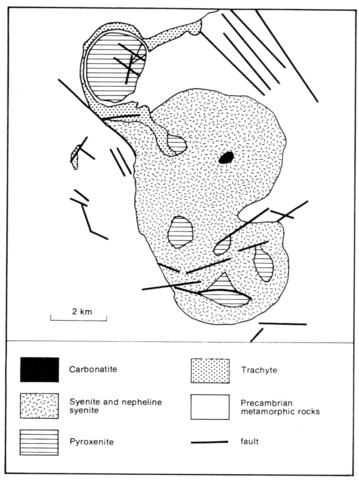stripes
Salitre comprises two interconnected intrusions cutting low grade metamorphic rocks of the Precambrian Bambui Group, which are domed around the intrusions. The smaller northwestern intrusion covers 15 km2 and is connected by trachytic outcrops to a southeastern complex of some 35 km2. A thick lateritic cover, up to 100 m thick, covers both intrusions. The larger intrusion is composed principally of peralkaline syenite and nepheline syenite, pyroxenite and carbonatite. The peralkaline syenites comprise perthite and aegirine/aegirine-augite, with sphene, apatite, zircon, monazite and magnetite. Filho (1974) points out the similarity of these rocks to fenites, but it is not clear whether they are true fenites or igneous syenites. Nepheline syenites consist of K-feldspar, a little albite, nepheline altered to zeolite, cancrinite, aegirine/aegirine-augite and accessory sphene and apatite. Five pyroxenite masses occur within the syenites and include jacupirangites with biotite (bebedourite), sodic diopside, aegirine, perovskite, magnetite, haematite, ilmenite, sphene, apatite, calcite and pyrite. Similar rocks without biotite are referred to as salitrite. The northwestern body is composed principally of biotite pyroxenite; olivine-bearing types also occur. Sovite is present in both major intrusions and contains perovskite, among other accessories (Rodrigues and Lima, 1984). A large body of trachyte extends between the two main intrusions and rings the northwestern one. Dykes are abundant, particularly to the south, and include tinguaites, pseudoleucite tinguaites and biotite trachytes.
FILHO, J.G.C.S. 1974. Prospeccao de uranio nas chamines alcalinas de Serra Negra e Salitre - MG. Boletim Comissao Nacional de Energia Nuclear, 9: 1-41.
HASUI, Y. and CORDANI, U.G. 1968. Idades potassio-argonio de rochas eruptivas Mesozoica do oeste mineiro e sul de Goias. Anais Congresso Brasileiro de Geologia, 22: 139-43.
RODRIGUES, C. de S. and LIMA, P.R.A. dos S. 1984. Carbonatitic complexes in Brazil. Companhia Brasileira de Metalurgia e Mineracao: 1-17

